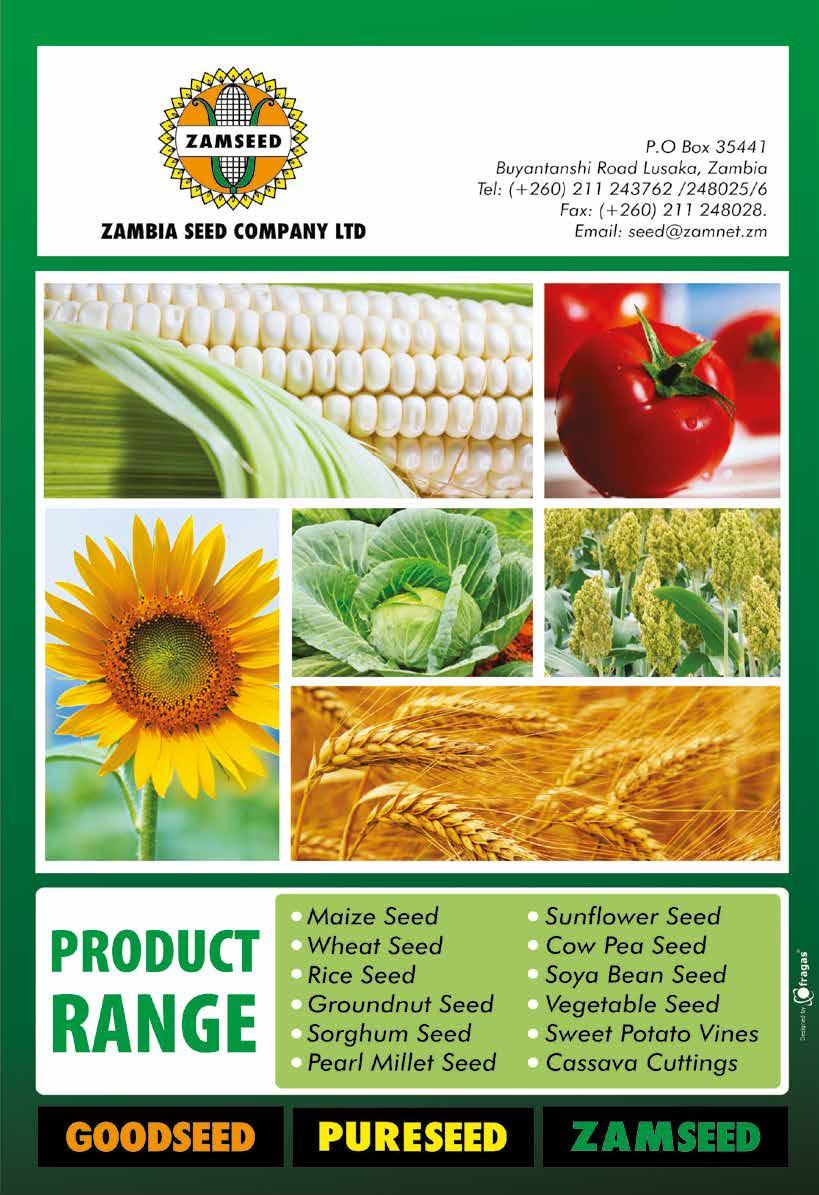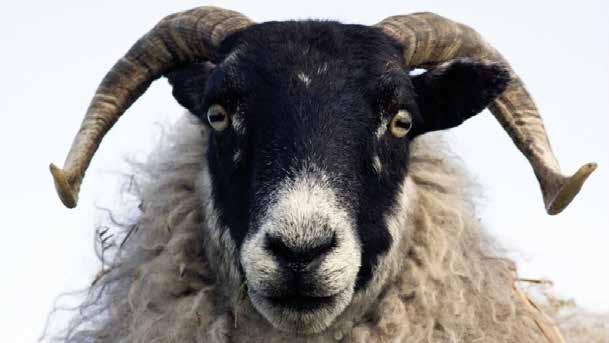
10 minute read
A Basic Guide to Raising Sheep
A BASIC GUIDE TO RAISING SHEEP BY COUNTRYSIDE WRITERS
If you enjoy eating lamb, are interther over nor underweight. They should ested in working with wool, or just move freely, without limping, on wellwant an easy-to-raise meat animal, trimmed feet. They should have sound here’s how to get started … mouths. (See illustrations.)
Advertisement
Sheep fill an important niche on many Before buying a sheep, observe the homesteads. If you want wool for fiber eyes and gums for signs of anemia. A arts, or if you like spring lamb but can’t healthy sheep will have blood-red gums, find (or afford) it in local markets, you and the arteries and membranes around don’t have to be convinced. But if you the eye will be red. Sheep with lots of have a little extra pasture land that’s not parasites will be anemic, so the gums and enough for a beef cow, or if you’d rather blood vessels in the eye will be pale. Seraise and butcher several smaller meat verely parasitized sheep may also exhibit Raising sheep and conservaanimals than one large one, sheep cerbottlejaw—lumps or swelling under the tion-minded land use go tainly deserve consideration. chin. hand-in-hand. Lambs are BUYING A common way to get started with sheep is to buy grade ewes and a purebred ram. But whatever you buy, there are certain things to look for. In the ram Because sheep with aged mouths do not do well on the range, some farmers remove these older ewes from their breeding flocks. In more productive regions, where feed is plentiful, these the only farm animals that can be put into choice market grade on pasture alone. But high quality pasture is needed. be especially conscious of the condition of the animal’s feet and legs. A ram without good legs and feet will not do his job. Avoid buying rams with questionable semen quality. older ewes may produce for a year or two longer. Broken-mouth or gummer ewes require the care of an excellent shepherd if they are to raise another crop of lambs successfully. Ten ewes and 16 lambs need half an acre for seven days of grazing when forage is 10 inches high. Sheep pro-duce the most pounds per acre on forage that is six inches high. Electric fences can be used to
A major contributing factor to poor reFEEDING divide pastures into sections. Eight of the productive performance is the epididymiRaising sheep and conservation-mind15 minerals sheep require are supplied tis, an infectious disease affecting the ed land use go hand-in-hand. Lambs when trace mineralized salt is offered free epididymitis adherent to the testicle. are the only farm animals that can be choice. Keep in mind that sheep are more There are no noticeable visual symptoms. put into choice market grade on pasture susceptible to copper toxicity than other The scrotum must be palpated to detect alone. But high quality pasture is needed. livestock the swelling and lesions occurring on the epididymitis. There should be two testicles in the scrotum, and neither should be grossly enlarged. The normal testicle has some firmness, but it is not hard. Check the ram’s sheath for lesions of any kind. A good pasture will carry five ewes and eight lambs per acre for the season. Experienced shepherds advise adding 25-50% more acreage to allow management flexibility. Legume-grass mixtures are recommended for pastures. Normal Eight of the 15 minerals sheep require are supplied when trace mineralized salt is offered free choice. Keep in mind that sheep are more susceptible to copper toxicity than other livestock are. Check with your local extension officers for
Examine the ewe’s udder to make sure regrowth periods of alfalfa-grass and recommendations on supplementation in there are no signs of mastitis, lumps or trefoil-grass mixtures are 15-20 days. Use your area. Salt should be offered in loose hard swelling. The normal udder should this as a guide for rotating your pastures. form rather than blocks. Outside, make be soft and pliable and have two funcAdjust your fenced areas so that your sure it’s covered. tional halves. Each half should have a teat. In general, the sheep should be neiflock will graze in each one for a week or less. In some areas, there is a soil selenium
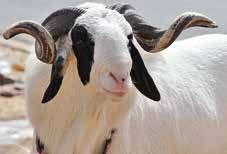
68.5 lbs
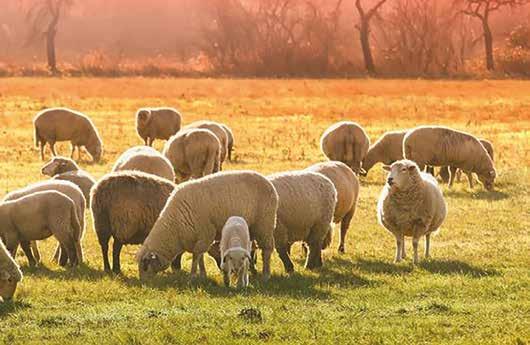
A popular mix for creep feeding young lambs, starting at two weeks of age even if they are to be finished on pasture is as follows: Corn, no cob, 68.5 lbs.; oats, 20 lbs.; linseed or soybean meal, 10 lbs.; trace mineralized salt, 0.5 lb.;
deficiency and it is advised that lambs receive an injection of selenium and vitamin E at two to four days of age.
ALTERNATIVE RATIONS, PER DAY, FOR EWES IN THE FIRST 4 MONTHS OF PREGNANCY
• Good quality alfalfa or clover hay, 3-1/2 to 4-1/2 pounds. • Good quality alfalfa or clover hay, three to four pounds; shredded corn stover or straw, one to 1-1/2 pounds. • Clover or alfalfa hay, three to four pounds; corn silage, one to two pounds. • Mixed legume and grass hay, four to five pounds. • Alfalfa or clover hay, one to two pounds; grass silage, four to eight pounds. • Good quality, low moisture legume grass silage, five to eight pounds. • With low protein hay such as grass fed with shredded corn stover or with straw, add a quarter to a half pound of 16% protein dairy mixture during the entire gestation period. Do the same for old or thin ewes, regardless of hay quality.
For ewes in the last month of pregnancy, some grain should be added, with the forage kept at least one-half legumes. Feed one-half to one pound of grain daily per ewe, keeping in mind that the forage should be of sufficient quality to supply the needed protein.
A sample grain ration, with good quality, half-legume hay, would be either shelled corn or whole oats alone or with a 50-50 mix of ground ear corn to whole oats.
Rams generally do not need grain except before or during the breeding season when they may be fed about one pound of grain mixture daily. They should not be allowed to become fat or sluggish.
Sheep need one to 1-1/2 gallons of fresh water daily. Water should be kept clean, as water contaminated with sheep manure is a common source of parasite infection.
A popular mix for creep feeding young lambs, starting at two weeks of age even if they are to be finished on pasture is as follows: Corn, no cob, 68.5 lbs.; oats, 20 lbs.; linseed or soybean meal, 10 lbs.; trace mineralized salt, 0.5 lb.;
Corn, no cob, 68.5 lbs.; oats, 20 lbs.; linseed or soybean meal, 10 lbs.; trace mineralized salt, 0.5 lb.; bonemeal or dicalcium phosphate, 1 lb. Feed high-quality alfalfa hay in a separate rack. Grind the feed at first and feed whole later.
For feeding ewes after lambing, about one pound of grain per head should be fed to those with one lamb and 1-1/2 to 2 lbs. per day to those with twin lambs. After two months of lactation, the ration should be reduced to the ration fed in the month before lambing.
Then, when lambs are weaned, the ewe rations should be reduced abruptly. After the withdrawal period, feed only a little hay for a week to aid in drying up the ewes.
For artificial rearing of orphan lambs, a number of commercial milk replacers are available. (If you have goat milk, by all means, use that.) Those designed specifically for lambs have a higher fat and protein, and a lower lactose content than calf milk replacers, which lambs often do not do well on. Choose one that contains approximately 30% fat, 20-24% protein, less than 25% lactose, and that will stay suspended in both warm and cold water.
Feeding time is the time for the shepherd to check the flock, observing not only whether the animals are eating well, but also their general condition. Feeders should be cleaned before each feeding. Provide 1-1/2 feet of rack space for each ewe.
One last feeding item: flushing is the process of feeding extra food for several weeks before breeding to get the ewes in prime condition. Recommendations of flushing vary considerably, with some farmers feeding some grain, putting the animals on lush pasture, or providing top-quality hay.
MANAGEMENT
General rules of thumb about housing are to allow 15 square feet per ewe with about 300 square feet of lot space. Housing should be well-ventilated because excess moisture contributes to sanitation and health problems. You should have enough single panels to build lambing pens for about 10% of your flock.
Some other general guidelines: Fifteen to 25 ewes can be watered for every foot of perimeter on a tank. A ram lamb can handle 15-25 ewes. A mature ram can handle 35-50 ewes.
Keep records on your sheep. A good record card includes the name, sex, birth date, ear tag number, comments on the birth (single, twin, etc.), the names of the sire and dam, body weights, the date bred, birth weights and sex of lambs, and a space for other comments. There should be a disease record, including space for symptoms and the treatment used. When the animal is removed from the flock, the reason should be noted.
HEALTH
Following good nutritional practices, providing the necessary immunizations, observing food sanitation, and controlling internal and external parasites will go a long way toward keeping your flock healthy. But a preventive health program requires constant vigilance by the shepherd. Particular care must be taken following periods of stress such as storms, after transporting sheep, or following an abrupt change of feed.
Watch for signs such as labored breathing, a dull, listless condition, a sheep refusing to eat or one that lies down a lot and goes off by itself.
The rectal thermometer is one tool that should be in your barn’s medicine chest. The sheep’s normal temperature ranges from 100.9° to 103.8°F, with the average normal rectal temperature of 102.3°F.
LAMBING
Before lambing time, it’s a good idea to line up a veterinarian or someone you know who has had lambing experience, so when you run into a problem you can’t handle you can get help in a hurry.
If a ewe has broken water and has been straining for more than 20-30 minutes and no lamb has appeared, you may have to intervene. Try to notice whether the ewe is tiring to time your intervention.
When you decide to help with the birth, clean the ewe and your hands and arms thoroughly with warm, soapy water, and apply an antiseptic lubricant. Consider using the clean, sterile plastic obstetrical sleeves used by inseminators.
Clean the ewe thoroughly, clipping dirty or excess wool from the area surrounding the external portion of the birth canal before thoroughly washing it.
Enter the ewe and try to determine the problem. The normal presentation for a lamb is head and front feet first. The head and feet you find in the canal may not necessarily belong to the same lamb, however. Don’t just start pulling—follow the legs back to the body or bodies to find out which parts go together.
Also, be cautious that the legs are both front legs, not one rear and one front leg.
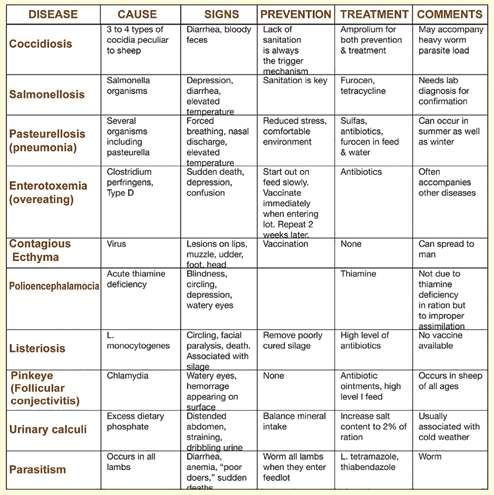
If twins are present, deliver the easiest presentation first.
Large-headed lambs may need lots of lubricant around the head. A lamb that’s stuck at the shoulders may be extracted by gently pulling alternatively on the front legs to reduce the shoulder width. Rotating the lamb about a quarter turn to make full use of the pelvic width usually helps move lambs stuck at the shoulder or locked by the hips.
In all cases, pull down and between the hind legs of the ewe, never straight out. That’s because the lamb is born naturally in a C-shaped arc.
If the legs and head are both back, buttocks presented first, and twins, call a vet. But if no vet is avail-able, try this:
If only the lamb’s tail is felt, it is possible a breech presentation exists. With assistance, the ewe is held up by the hind legs and the lamb pushed forward, the gloved hand is carefully introduced, pulling the flexed hind leg back, then the other leg is positioned similarly. Care should be exercised in not penetrating the lamb bed.
In births where the lamb comes out backward, once the delivery is started it should be completed as quickly as possible because the lamb will try to breath as soon as the navel cord is pinched or broken. It could suffocate if it takes too long. The lamb’s nostrils should be cleared as soon as it comes out.
